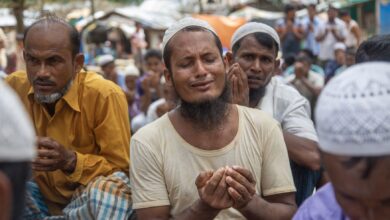
In the late afternoon of April 24, Mandalay resident Hpone Myint Moe was on his way home after having a few beers with a friend he hadn’t seen in a while. Before he got there, however, four armed men grabbed him and threw him in a van. His family never saw him alive again.
The next day, a group calling itself “Thwe Thout” (meaning “blood-sworn comrades”) posted a screenshot of an article about the abduction on the social media platform Telegram. The group said it would “pass judgement” on the 50-year-old Hpone Myint Moe, who happened to be the brother of an MP from the National League for Democracy (NLD), the party ousted from power in February of last year. A photo of Zaw Zaw Aung, the MP, in a yellow pinni—a traditional garment seen as a symbol of the NLD—appeared with the article.
Two days later, Hpone Myint Moe’s body turned up at a local morgue. It was covered with bruises and had a gunshot wound to the neck. He had also been stabbed in the shoulder, and his skull was crushed.
Family members—who fled Mandalay soon after claiming the body and giving it a hasty cremation—say that the victim would not have seen the attack coming. “He wouldn’t even have known why he was killed this way,” said one relative who believed, like others in the family, that Hpone Myint Moe’s violent death had something to do with his brother.
It was just three days earlier that Thwe Thout announced the launch of “Operation Red”—a campaign targeting members and supporters of the NLD, as well as anyone belonging to any of the various anti-regime resistance groups that have emerged since last year’s coup. Journalists investigating the military’s actions would not be safe, either, it said. Perhaps most chillingly, the group also issued death threats against relatives of prominent junta opponents, signalling that it was about to embark on an indiscriminate killing spree.
Over the next two weeks, it proved true to its word. According to a statement released by the NLD, a total of 14 people—seven NLD members and seven others in some way associated with the party—had been murdered by Thwe Thout as of May 5. Eight of these victims were killed in Mandalay, while the remaining six were scattered around the country, in Tanintharyi, Naypyitaw, Yangon, and Bago.

Fuelling the fire
Thwe Thout claims that it was formed in reaction to the “lawlessness” of anti-regime groups that have targeted military informants and others accused of supporting the junta. It also relies heavily on “race and religion” rhetoric to justify its crimes, suggesting that it is a newer, even more extreme version of Buddhist nationalist groups like Ma Ba Tha.
Few, however, believe that it is an organic movement that has grown out of the chaos of the past year. And far from seeking to restore order, it appears to be intent on amplifying the violence that has taken hold in the country.
This would seem to be by design, according to one former high-ranking police official who recalled how previous regimes typically added fuel to fires that they couldn’t put out.
“When there is insecurity in society, they [the military] seek to perpetuate it so that they can step in and show who’s in control,” he said. “As people grow more concerned about their safety, the army moves to widen its role on the pretext of providing security.”
For generations, Myanmar’s military has used the presence of real or imagined threats to present itself as a stabilising influence. But it has always been during times of unrest, when its own position has seemed most at risk, that groups like Thwe Thout have tended to emerge from the shadows.
In the not-so-distant past, Thwe Thout might have gone by the name of Swan Arr Shin (“masters of force”). Implicated in some of the worst episodes of Myanmar’s recent political history, this thuggish outfit was deployed by the military during the 1988 pro-democracy uprising, the 2003 Depayin massacre, and the 2007 Saffron Revolution. An investigation by Myanmar Now in 2015 revealed how it had reared its head again that year during crackdowns on student protests and labour strikes in Yangon.

Recruited from the ranks of Myanmar’s criminal underclass, members of Swan Arr Shin were paid to terrorise groups that challenged the military’s grip on power. According to a 2009 US embassy cable published by Wikileaks, then police chief Khin Yi (who now serves as the junta’s minister of immigration and vice-chair of the military-backed Union Solidarity and Development Party) admitted to UN human rights rapporteur for Myanmar Tomás Ojea Quintana that the regime also provided them with training and sometimes even weapons.
The current junta, however, has been more coy about its ties to groups like Thwe Thout. At a press conference held on April 27, its spokesperson, Maj-Gen Zaw Min Tun, conceded—after previously denying—that the military was behind the creation of the notorious Pyu Saw Htee militias active in parts of the country where anti-regime People’s Defence Force (PDF) groups have been especially strong, but disavowed any connection to Thwe Thout.
“The government has been forming those public militias in accordance with the demands of local people. But we have nothing to do with the rest of the groups,” he said.
But the former police official who spoke to Myanmar Now said there was no real doubt about Thwe Thout’s origins, or what its mission was.
Thugs and criminals will always be their stooges – former senior police intelligence official
“If you want to know what their next move will be, all you have to do is look to the past,” he said, citing his years of working as a senior police intelligence official under previous regimes, when Thwe Thout’s earlier incarnations were always an integral part of the military’s social control mechanism.
“Thugs and criminals will always be their stooges,” added the official, who now lives outside of Myanmar after resigning from his position last year in protest over the coup.
Urban jungle justice
Unlike the soldiers and Pyu Saw Htee militias that have spread across many parts of Myanmar’s countryside like a devastating plague, Thwe Thout has been most active in its urban centres.
It’s no coincidence that the majority of attacks so far have been in Mandalay, a city that saw the emergence of many urban guerrilla groups in the wake of the coup. Ironically, as these groups have been forced to scale back their operations due to crackdowns, Thwe Thout has stepped in to keep the city’s inhabitants on edge.
According to one Mandalay-based activist, Thwe Thout now has a monopoly on violence in the city, as most urban guerrillas are either in prison or in hiding.
“They have taken advantage of this situation to start carrying out these killings,” he said, speaking on condition of anonymity.
According to Yee Mon, the defence minister for the shadow National Unity Government (NUG), it’s clear who is behind the spate of recent murders in the city. In a recent interview with Myanmar Now, he even pointed a finger at a specific group within the military that he holds responsible for the attacks.
“Junta officials from the military’s Central Regional Command are the ones who founded groups in Mandalay to target the families of NLD and PDF members,” he said.
A week after Hpone Myint Sone’s murder, an interview with a member of Thwe Thout went viral on Facebook. The interviewee’s voice was altered and the origin of the audio file was unknown.
Claiming that Thwe Thout was formed by people “who love race and religion, who genuinely love the country and want it to be really developed and be on a peaceful path,” the interviewee went on to take responsibility for the first four killings in Mandalay.
Among his victims, he said, were Khin Maung Thein and his wife Kha Kha, the owners of the Sein Win Win teashop in the city’s Chanayethazan Township. They were abducted just hours after Hpone Myint Sone, shot and stabbed repeatedly, and dumped outside of the local NLD office. Miraculously, Kha Kha survived this brutal attack and was taken to a hospital for emergency treatment, according to a relative.
Khin Maung Thein’s brother-in-law U Tin, who went missing while searching for the couple, was not so fortunate. His body was found at a different location, but with similar wounds and with the same Thwe Thout calling card: a red lanyard bearing the group’s logo, which features a man with two swords, crouched and ready to pounce. Khin Maung Thein and U Tin were both NLD members.
According to a Mandalay resident who spoke to Myanmar Now days after the murders, Khin Maung Thein and his wife were also close to Zaw Myint Maung, the jailed NLD vice-chair who was ousted as Mandalay Region’s chief minister on the day of the coup.
“They participated actively during the NLD’s election campaigns,” said the resident, who did not want to be named.
Taking evident pride in his actions, the interviewee said that if the authorities decided to prosecute him or his comrades, they would “go to the gallows with our heads held high.”
In the meantime, however, he vowed not only to continue the killing spree, but to spread it to every corner of the country.
“When there is no law, there can only be jungle justice,” he said.
Proxy warfare
After a year that has seen unprecedented levels of violence, it now appears that even worse may be yet to come. As the Mandalay activist acknowledged, Thwe Thout will not have much difficulty recruiting new members.
“Some who lost relatives may hold a grudge,” he said, referring to those related to suspected informants killed by anti-regime groups. “Especially if they are already inclined to support the military, they can easily be persuaded to carry out these kinds of activities.”
Already, new groups associated with Thwe Thout have begun to crop up, like one in southern Myanmar’s Tanintharyi Region that calls itself Sonye (“red kite”). While it has yet to commit any murders, it has reportedly issued death threats against NLD members and their relatives.
And there have also been reprisals against those suspected of backing Thwe Thout. On May 1, a man named Yan Naing Shwe, who was a member of the junta’s local administrative council and a former USDP candidate, was gunned down in Yangon’s Thanlyin Township. An urban guerrilla group claimed responsibility for the killing, but Thwe Thout denied that Yan Naing Shwe was a member of the group.
I believe they are trying to make it look like everyone is killing everyone else
While intimidating regime opponents is undoubtedly one of the group’s chief goals, from the junta’s perspective, its real value may lie in its ability to deepen the sense of insecurity that many already feel, according to some observers.
“I believe they are trying to make it look like everyone is killing everyone else,” said a relative of Hpone Myint Moe who spoke to Myanmar Now on condition of anonymity.
“If the intent of those people is to kill anyone who supports the NLD, and if the people on the side of the resistance target them in turn, then the situation will spin out of control. And that is exactly what they want,” he added.
Unable to assert its authority in any other way, the regime may be hoping that a further deterioration of the situation will lead to greater acceptance of its rule among a population already reeling from the country’s ongoing death spiral.
Whether this proves to be the case or not, the junta has already demonstrated, in its countless attacks on villages in Myanmar’s rural heartland, a willingness to rely on scorched-earth tactics. This may be why many find it easy to believe that it is now preparing to take a similar approach in its cities, albeit with an even greater reliance on proxies.
“I’m sure that [Thwe Thout] is controlled by the junta,” said Hpone Myint Moe’s relative. “This is definitely orchestrated by those ‘up above’. None of this could happen without their consent.”
Additional reporting by Han Thit and Mary Hnin.



